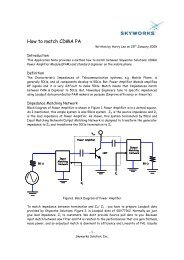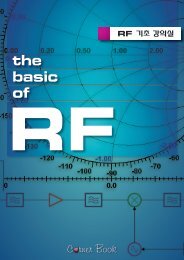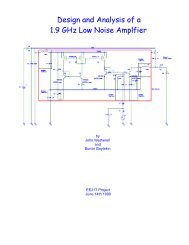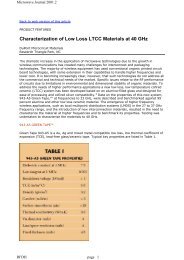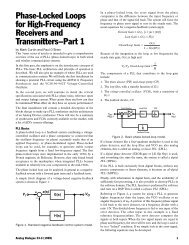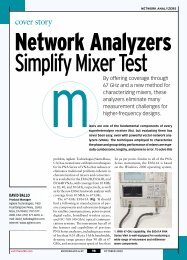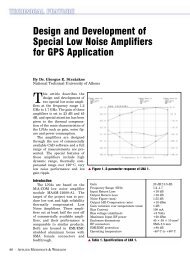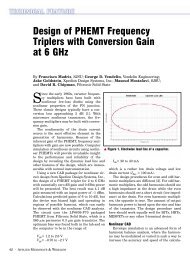Unfiltered FQPSK: Another Interpretation and Further Enhancements
Unfiltered FQPSK: Another Interpretation and Further Enhancements
Unfiltered FQPSK: Another Interpretation and Further Enhancements
You also want an ePaper? Increase the reach of your titles
YUMPU automatically turns print PDFs into web optimized ePapers that Google loves.
d Q,n–1 results in a transition (positive<br />
or negative) <strong>and</strong> d Q,n–1 , d Q,n<br />
results in a transition (positive or<br />
negative).<br />
8d<br />
IV. If d I,n–1 =1, d I,n =–1 (a negative<br />
going transition on the I sequence),<br />
then<br />
A. y I (t)=s 12 (t–nT s ) if d Q,n–2 , d Q,n–1<br />
results in no transition <strong>and</strong> d Q,n–1 ,<br />
d Q,n results in no transition.<br />
B. y I (t)=s 13 (t–nT s ) if d Q,n–2 , d Q,n–1<br />
results in no transition <strong>and</strong> d Q,n–1 ,<br />
d Q,n results in a transition (positive<br />
or negative).<br />
C. y I (t)=s 14 (t–nT s ) if d Q,n–2 , d Q,n–1<br />
results in a transition (positive or<br />
negative) <strong>and</strong> d Q,n–1 , d Q,n results in<br />
no transition.<br />
D. y I (t)=s 15 (t–nT s ) if d Q,n–2 , d Q,n–1<br />
results in a transition (positive or<br />
negative) <strong>and</strong> d Q,n–1 , d Q,n results in a<br />
transition (positive or negative).<br />
Making use of the signal properties<br />
in (7a) <strong>and</strong> (7b), the mapping<br />
conditions in (8a-8d) for the I channel<br />
baseb<strong>and</strong> output can be summarized<br />
in a concise form (Table 1). A<br />
similar construction for the baseb<strong>and</strong><br />
Q-channel transmitted waveform<br />
y Q (t) = s Q (t–T s /2) in the nth<br />
signaling interval nT s ≤ t ≤ (n+1)T s<br />
in terms of the transition properties<br />
of the I <strong>and</strong> Q data symbol<br />
sequences {d in } <strong>and</strong> {d Qn }, respectively,<br />
can be obtained analogous to<br />
(8a-d). The results are summarized<br />
in Table 2. Note that the subscript i<br />
of the transmitted signal s i (t–nT s ) or<br />
s i (t–(n+½)T s ) as appropriate is the<br />
binary coded decimal (BCD) equivalent<br />
of the three transitions.<br />
Applying the mappings in Tables<br />
1 <strong>and</strong> 2 to the I <strong>and</strong> Q data<br />
sequences of Figure 2 produces the<br />
identical I <strong>and</strong> Q baseb<strong>and</strong> transmitted<br />
signals to those that would be<br />
produced by passing the I <strong>and</strong> QIJF<br />
encoder outputs of this figure<br />
through the cross-correlator (half<br />
symbol mapping) of the <strong>FQPSK</strong><br />
(XPSK) scheme as described in [4]<br />
(Figure 4). Thus, we conclude that<br />
for arbitrary I <strong>and</strong> Q input sequences,<br />
<strong>FQPSK</strong> can alternately be generated<br />
by the symbol-by-symbol mappings<br />
of Tables 1 <strong>and</strong> 2 as applied to<br />
these sequences.<br />
A new <strong>and</strong> improved <strong>FQPSK</strong><br />
As discussed above, the symbolby-symbol<br />
mapping representation<br />
of <strong>FQPSK</strong> identifies the fact that<br />
four out of the sixteen possible<br />
transmitted waveforms, namely<br />
s 5 (t), s 6 (t), s 13 (t) <strong>and</strong> s 14 (t) have a<br />
slope discontinuity at their midpoint.<br />
Thus, for r<strong>and</strong>om I <strong>and</strong> Q data<br />
symbol sequences, on the average<br />
the transmitted <strong>FQPSK</strong> waveform<br />
will likewise have a slope discontinuity<br />
at one quarter of the uniform<br />
sampling time instants. To prevent<br />
this from occurring, we now redefine<br />
FEBRUARY 2000 · 83






